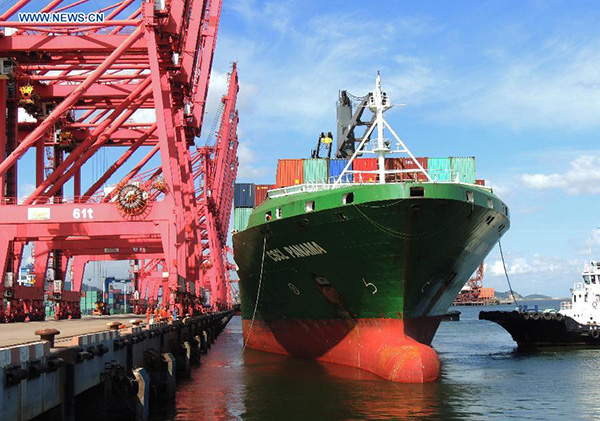


Containers are unloaded from a cargo ship in Lianyungang, East China's Jiangsu province, on Sept 8, 2015. [Photo/Xinhua]
China's exports fell by 1.6 percent year-on-year to 10.06 trillion yuan ($1.49 trillion) in the first three quarters of the year, while overall trade performance improved on a quarterly basis, customs data showed on Thursday.
Foreign trade between January and September was down by 1.9 percent to 17.53 trillion yuan from a year earlier, with imports dropping by 2.3 percent to 7.47 trillion yuan, according to the General Administration of Customs.
Customs spokesman Huang Songping attributed the weak figures to sluggish world growth and the lack of effective support for global trade.
"As China continues to face weak domestic and global market demand, we have discovered that its traditional advantage in foreign trade has shown many weak points and confronted difficulties such as trade protectionism, rising operational costs and limited market channels," said Huang.
But China's foreign trade has shown signs of stabilizing, since it rose by 1.1 percent year-on-year in the third quarter, he said.
He said the government will take adequate measures to support foreign trade, including further cutting taxes for domestic companies and improving research and development capabilities for high-end manufacturers, as well as enlarging trade volume with countries and regions along the Belt and Road Initiative routes.
Huang said the depreciation of the Chinese yuan could benefit domestic exporters, but would also raise the import costs of production materials, since processing trade still remains a major part of China's trade pattern.
"An economy's currency fluctuations could have a mixed impact on trade growth due to cross-border cooperation along the global industrial value chain, undermining efforts to boost exports," Huang said.
China's exports to countries along the Belt and Road routes increased between January and September. For example, exports to Pakistan grew by 14.9 percent; to Russia, by 14 percent; Poland, 11.7 percent; Bangladesh, 9.6 percent; and India, 7.8 percent.
Meanwhile, exports to the United States, China's second-biggest trade partner, fell by 1.9 percent, and those to members of the Association of Southeast Asian Nations, its third-largest trade partner, shrank by 1.9 percent.
Machinery and electronic products as well as goods in labor-intensive sectors, including textiles and toys, accounted for the lion's share of export goods, and private companies still led the country's exports.
Joneaa Jeans, a Dongguan-based garment company, was one of the major exporters of original equipment manufacturer jeans, which are used as other companies' end products, to Europe last year, with sales of 130 million yuan. However, its overseas sales declined this year, and exports dropped to 47 million yuan due to weak market response.
Xie Qundi, president of Joneaa Jeans, said her company is looking for new partners in emerging markets, especially in South America and Southeast Asia. It has also added a 12-member team to design new styles of jeans for the needs of various foreign clients.
"Even though orders from abroad did show some increase in September, they are much fewer than last year," said Xie. "Our independent brands and the depreciation of the yuan certainly will help the sales in overseas markets."
 Home-made plane completes test flight in Chicago
Home-made plane completes test flight in Chicago The untold stories of women in the Long March
The untold stories of women in the Long March Female soldiers on Frigate Jingzhou
Female soldiers on Frigate Jingzhou Top 10 most beautiful Chinese athletes in Rio
Top 10 most beautiful Chinese athletes in Rio Shenzhen seizes 549 tons of illegally smuggled clothing
Shenzhen seizes 549 tons of illegally smuggled clothing Chinese actor Wang Baoqiang divorces wife, fires manager
Chinese actor Wang Baoqiang divorces wife, fires manager Hangzhou: host city of G20 Summit
Hangzhou: host city of G20 Summit New hovercrafts debut in landing exercise
New hovercrafts debut in landing exercise Woman sets Guinness World Record with 17-month-long pregnancy
Woman sets Guinness World Record with 17-month-long pregnancy Top 10 livable Chinese cities
Top 10 livable Chinese cities Top 20 hottest women in the world in 2014
Top 20 hottest women in the world in 2014 Top 10 hardest languages to learn
Top 10 hardest languages to learn China’s Top 10 Unique Bridges, Highways and Roads
China’s Top 10 Unique Bridges, Highways and Roads Trading sex for travel
Trading sex for travel ‘Voice of China’ helps pave way for Xinjiang music talent
‘Voice of China’ helps pave way for Xinjiang music talent Beijing car-sharers feel driven out
Beijing car-sharers feel driven out Google’s Neural Machine Translation sparks debate over the future of AI
Google’s Neural Machine Translation sparks debate over the future of AIDay|Week